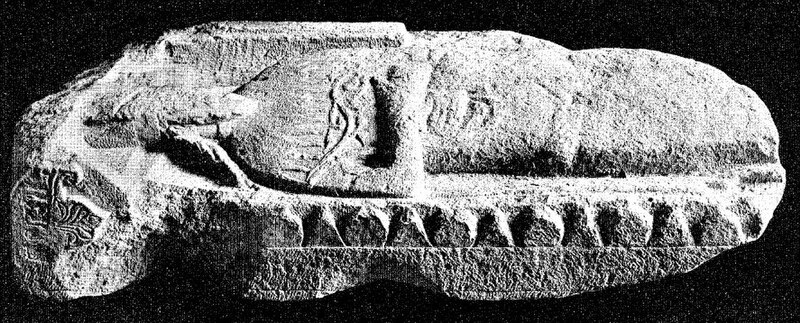-
August 26, 2012, 01:59 AM
#1
 [HISTORICAL ISSUE] - The tomb from the Curtea de Arges Princely Church
[HISTORICAL ISSUE] - The tomb from the Curtea de Arges Princely Church
I've been having some discussions with Bagatyr on the topic of the grave of Vladislav Vlaicu (or possibly Radu I) a Wallachian Voivode from the XIVth century so thought I would share here my research and documentation regarding the tomb for everyone's benefit. Most of the text has been translated by myself from Romanian so excuse some of the grammar.
The grave from the Princely Church Curtea de Arges was discovered in 1920 when the church was undertaking repairs. The discovery belongs to the historian Virgil Draghiceanu who also supervised the archaeological dig. The tomb contained the human remains of a certain voivode dated from around the second half of the XIVth century. There were several theories regarding the identity of the voivode such as Basarab I, Vladislav Vlaicu or Radu I.
The tombstone is rectangular and is made out of Albeşti limestone. The character carved on the tombstone is wearing a long robe with a collar on the shoulders.


The voivode inside the tomb was found covered with a silk shroud which was very damaged.
This is an original photo from the first opening of the tomb

And this is a current photograph as the body was exhumed for a DNA sample analysis

The character inside the tomb wears a purple tunic reaching down to the femur and is tight around the body. The tunic is embroidered and decorated with pearls, especially the sleeves (sleeves and elbows), and is closed in front with 30 golden buttons enameled with green to represent the Basarab dynasty coat of arms. About 20 similar buttons decorated the sleeves and the forearms. The voivode has a leather belt lined with velvet, adorned with pearls and diamonds with gold stars at the corners. The belt closes with a golden beltbuckle. The beltbuckle is a miniature castle in the center of which there is a female swan head.
Under the tunic there is a vest of which only the neck, sleeves and front borders were preserved and they are richly adorned with pearls. From the shirt only the collar lace was preserved, it was made out of silk and thread using the "Pointe de Venise" technique. The pants and the shoes have not been preserved but the latter are likely to have had sharp long peaks after the fashion of the time. On its head the voivode is wearing a diadem decorated with pearls which had slipped and when the tomb was discovered it was resting under the chin. The hands were tied together on the chest forming in patriarchal cross and the hands were covered by gloves adorned with pearls. Four rings were found on the voivode's fingers each having various inscriptions.
The Romanian historian Constantin Giurescu drew the following conclusion from the grave:
"The voiode from the grave as seen from his clothing and ornaments could have sat next to any other contemporary monarch of Europe. In the XIVth century at the court of the voivods there wasn't a humble life of shepherds and peasants as some might have thought, but a life full of all the glam and glitter associated with a society of nobles, of boyars with big landholdings and with powerful links with the feudals of the Angevin dinasty but also with Byzantium and with the two imitators of the Byzantines, the Bulgarian and Serbian Tsars".
This is reconstruction of the person found within the tomb by Radu Oltean

And another reconstruction

The buttons
The first set of buttons contain the dynastic emblem of the House of Basarab. The buttons are made out of silver and gilded with gold.




The coat of arms on the buttons consists of a split French shield, the first field being split into eight pieces which alternated with green and gold. The second field is solid gold.
The coin specialist Octavian Iliescu believes that the wearer attributed the emblem to himself as the metal used (gold) was higher than that of the senior Hungarian arms (silver). The heraldist Dan Cernovodeanu is of the same opinion, as he compares the emblem with that of Stephen the Great, found in Tetraevangel of 1502. The latter adopts a similar chromatic field of azure-green alternative that could come from multiple blood ties between the ruling families of Basarab and Musat.
This is a reconstruction of the color on the buttons representing the Basarab coat of arms

The coat of arms of the Moldavian Musatins from the time of Stefan the Great

The second set of buttons each contain a letter in the following order R, O, I. The buttons are made out of silver and gilded with gold.



Currently all the buttons are in the National History Museum in Bucharest.
The rings
Ring with the trapezoidal section extended towards the mount, molded at the same time as the chaton. On the outside of the ring the inscription is in Latin with Gothic capitals. At the beginning of the inscription there is an "Ancre" cross and the words are separated by rosettes. The remaining two sides are decorated with lozenges. On one side and the other of the mount there is a trapezoidal filed with a flower enrolled in an eight-pointed star. On one side there is a some small inscription: AL-MA. The oval chaton with a wide edge and has an ancient stone (probably a ruby) chipped today, which has a carving of the bust of a man with laurel wreath. The edge of the mount is decorated with vegetable ornaments. The inscription is in Latin: IESUS AUTEM TRANSIENS PER MEDI (UM ILORUM IBAT).

Ring with a rectangular section, thinning towards the interior. On the outside there is an inscription in Latin capital letters. At the beginning of the inscription there is a cross with equal arms and between words there are two vertical dots. The chaton is in the shape of a truncated and has on it a black diamond. One both sides of the mount the ring widens and has two grooves. The latin inscription is: AVE MARIA GRACIA PLENA DOMINUS TE (CUM). This approximately translates to Hail Mary full of grace the Lord is with you.

Ring with a semicircular in section, on the outside there is an inscription in relief with Gothic capitals. A black diamond is mounted om the chaton in the shape of a truncated pyramid. It is flanked by two lions with thier heads turned to the right and to the left and one of their paws is resting on the diamond mount. The is nscription HILF + GOTH.

Ring with of triangular section, unadorned. The mount is welded to ring in the shape of a flower with six rounded petals which contain six golden pearls fastened with rivets.

Currently all the rings are in the National History Museum in Bucharest.
The Belt Buckle
The belt buckle is made out of gold and was designed as a complex of medieval architecture, namely the gate of a fortress wall that opens into an enclosure. The piece consists of three parts molded and articulated by braces. The first two pieces represent the side towers which have a hexagonal shape with two buttresses on each side.
The buckle's connection to the belt is achieved through brace and cut plates each provided with two rivets. The central part of the buckle is the gate tower, buildings with balconies, vine under the bridge and the portal. Underneath this there is a swan with a female head on a blue enamel background.
The side towers and the tower gate are represented on the same level plane, the latter having the facade decorated with two rows of arches and battlements to watch the road. The terrace of the tower is canted with a portico openings in horseshoe, whose roof has four slopes decorated with fleurons. Underneath the portal there is an ornament made of vegetable stalks, volutes and lily flowers.
Inside the portal to a closed area with email, there is a female swan head cast in silver (the figure may represent the folk figure named Melusine, feminine spirit of fresh waters in sacred springs and rivers). On two inverted pyramid trunks supported by a column two characters are represented, a knight and a lady, rendered in profile.
Several images of the golden belt buckle




Currently the belt is in the National History Museum in Bucharest.
Last edited by SpyrosM91; August 30, 2012 at 01:50 PM.
-
August 26, 2012, 07:49 AM
#2
 Re: The tomb from the Curtea de Arges Princely Church
Re: The tomb from the Curtea de Arges Princely Church
This is the first time I'm reading about this tomb. Very interesting. +
-
August 26, 2012, 08:11 AM
#3
 Re: The tomb from the Curtea de Arges Princely Church
Re: The tomb from the Curtea de Arges Princely Church
-
August 29, 2012, 06:37 AM
#4
 Re: The tomb from the Curtea de Arges Princely Church
Re: The tomb from the Curtea de Arges Princely Church
wow...România - plin de istoria!
 Posting Permissions
Posting Permissions
- You may not post new threads
- You may not post replies
- You may not post attachments
- You may not edit your posts
-
Forum Rules































 Reply With Quote
Reply With Quote









